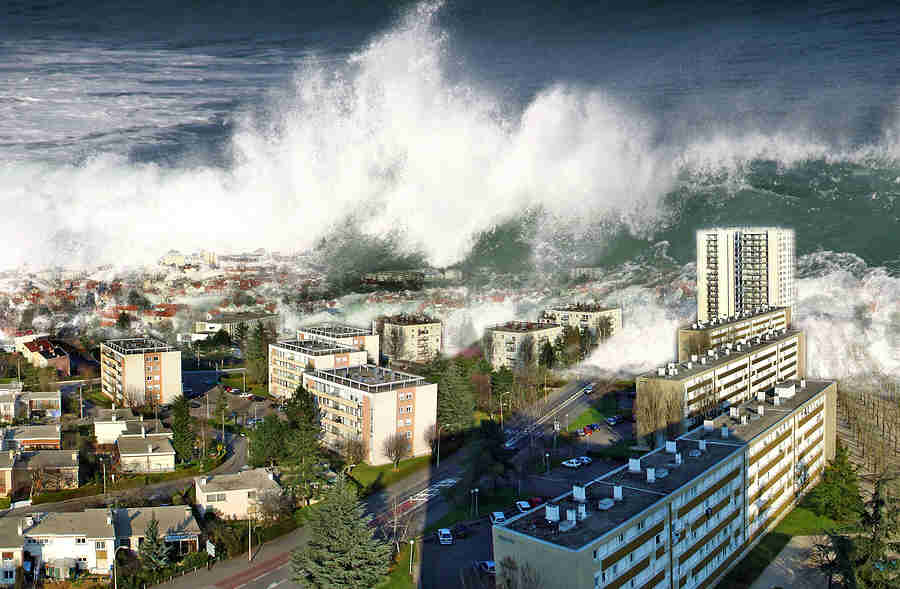 *Image From DWNetwork.inc
*Image From DWNetwork.inc
It was of course the only story on CNN this morning as we woke up to the news of the 8.9M Earthquake, followed by a tsunami that hit Japan. Currently the tsunami is still making it’s path of destruction, and has made it’s way to Hawaii while 53 countries in all currently have a tsunami watch on. The devastation will be huge, and those beginning images out of Japan are incredibly sad to see. Please continue to keep those affected in your thoughts and prayers as the days ahead will difficult to say the least.
11 Facts About Tsunamis
- A tsunami is a series of sea waves caused by an underwater earthquake, landslide, or volcanic eruption. More rarely, a tsunami can be generated by a giant meteor impact with the ocean.
- A tsunami is not just one wave but a series of waves or a “wave train.”
- Many witnesses say a tsunami sounds like a freight train.
- When the ocean is deep, tsunamis may be less than a foot high on the ocean’s surface, can travel at speeds up to 500 mph without being noticed and cross the entire ocean in less than a day.
- Once a tsunami reaches the shallow water near the coast, it slows down. The top of the wave moves faster than the bottom, causing the sea to rise dramatically, as much as 100 feet at times.
- Tsunami waves can be as long as 60 miles and be as far as an hour apart. These waves can cross entire oceans without losing much energy.
- Flooding can reach land 1000 feet (300 meters) from the coastline and the dangerous waves have enough force to lift giant boulders, flip vehicles, and demolish houses.
- Scientists can accurately estimate the time when a tsunami will arrive almost anywhere around the world based on calculations using the depth of the water, distances from one place to another, and the time that the earthquake or other event occurred.
- Hawaii is the U.S. state at greatest risk for a tsunami – they get about one per year and a damaging one every 7 years. California, Oregon and Washington experience a damaging tsunami every 18 years.
- In 2004, the Indian Ocean tsunami was caused by an earthquake that is thought to have had the energy of 23,000 atomic bombs.
- Within hours of the earthquake in 2004, killer waves radiating from the epicenter slammed into the coastline of 11 countries, damaging countries from east Africa to Thailand. By the end of the day, the tsunami had already killed 150,000 people. The final death toll was 283,000.
On July 12, 1993 a magnitude 7.8 earthquake in the Sea of Japan produced tsunami that totally destroyed the southern half of Okushiri Island. Waves were greater than 30 feet and some could have been 100 feet. The earthquake was about 50 miles offshore and the tsunami arrived within minutes. 120 people died.
The states most at risk for Tsunami are California, Hawaii, Oregon and Washington. Hawaii is at greatest risk and they have about 1 tsunami a year and a dangerous tsunami about every 7 years.
On March 28, 1964 an extremely large earthquake (magnitude 8.4) struck Alaska. It caused tsunami waves that were very destructive in southeastern Alaska, in Vancouver Island, Canada, and in the States of Washington, California and Hawaii. Waves ranged in size from 6 to 21 feet. The tsunami killed more than 120 people and damages costing more than $106 million. It was the costliest tsunami ever to strike the Western United States and Canada.
~Dangerous Planet Website
Although a large asteroid impact is highly unlikely, scientists studying the possibility have decided that a moderately large asteroid or about 5-6 km in diameter falling in the middle of the Atlantic Ocean, would generate a tsunami that would travel all the way to the Appalachian Mountains in the upper two-thirds of the United States. Coastal cities would be wiped out by such a tsunami.
Nuclear explosions could possible create tsunami but none have ever been generated from testing yet. Furthermore, such testing is currently banned by international treaty.
Tsunami waves hit Hawaii in the early morning hours Friday and were sweeping through the island chain after an earthquake in Japan sparked evacuations throughout the Pacific and as far as the U.S. western coast.
The Pacific Tsunami Warning Center said Kauai was the first of the Hawaiian islands hit by the tsunami. Water rushed ashore in Honolulu, swamping the beach in Waikiki and surging over the break wall in the world-famous resort but stopping short of the area's high-rise hotels.
Waves about 3 feet (a meter) high were recorded on Oahu and Kauai, and officials warned that the waves would continue and could become larger.
Roadways and beaches were empty as the tsunami struck the state, which had hours to prepare. Residents in coastal areas of Hawaii were sent to refuge areas at community centers and schools while tourists in Waikiki were moved to higher floors of their hotels. People waited in long lines stocking up on gas, bottled water, canned food and generators, and officials told residents to stock up on water and fill their cars with gas.
"People here are a little concerned," Malia Zimmerman, publisher of the Hawaii Reporter, told FoxNews.com from her home in Oahu. "We're all in a holding pattern right now."
~Fox News

No comments:
Post a Comment
Thank you for your comments!